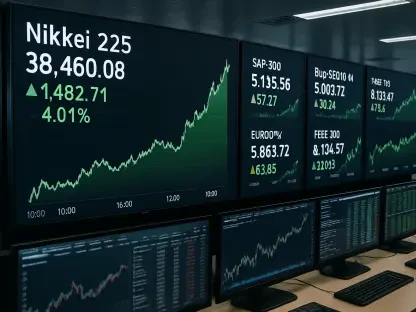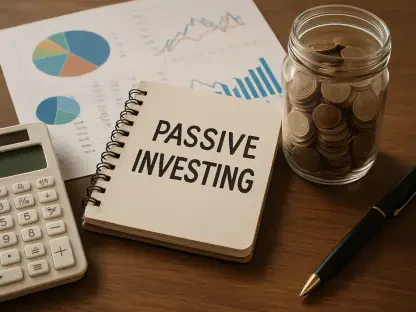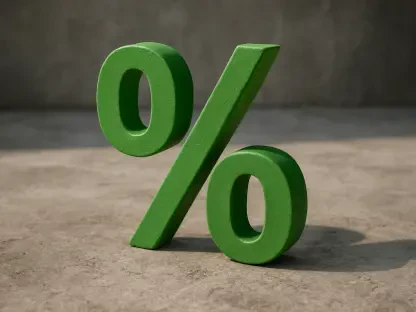In the ever-evolving financial landscape, mortgage rates have become a focal point for investors, homeowners, and policymakers alike. The recent uptick in these rates highlights a significant shift from the declining trends earlier in the summer, revealing underlying economic forces at play. Observers are paying close attention to the ripple effects within the broader housing market, as these rate increases coincide with growing economic uncertainty, notably influenced by international trade policies and domestic economic variables. The complexity of this milieu intertwines with the “lock-in effect,” a phenomenon increasingly impacting real estate decisions as potential home sellers with previously low mortgage rates hesitate to enter the market at today’s higher figures.
Understanding Mortgage Rate Fluctuations
Recent Trends and Their Impacts
The mortgage rate narrative in 2025 captures a significant turnaround from early summer’s decline, with rates witnessing a gradual rise in recent weeks. Data from financial surveys show this upward movement, with averages ranging between 6.67% and 6.80%. These moderate increases have sparked discussions among financial experts, as they reflect broader socioeconomic trends. The factors influencing rate dynamics are multifaceted, including economic policies, market volatility, and the resultant investor sentiment. This convergence of elements emphasizes the sensitivity of mortgage rates to even minor shifts in economic indicators, providing insights into the broader financial ecosystem’s interconnected nature.
In essence, the fluctuations experienced in recent times can be attributed to rising Treasury yields and the Federal Reserve’s stance on monetary policy. The increased rates have also resulted in a tangible reduction in mortgage application volumes, underscoring the pressing response from both buyers and refinancers. As these rates stabilize at elevated levels, their broader implications become evident, affecting buyers’ purchasing power, sellers’ willingness to transact, and overall housing affordability. This period serves as a microcosm of the delicate balance between market forces, showcasing how integrated financial indicators dictate mortgage dynamics and, by extension, housing market health.
Economic Underpinnings Driving Changes
Delving deeper into the economic forces influencing mortgage rates reveals a landscape shaped significantly by trade policies and fiscal discussions on a global scale. Renewed concerns surrounding international tariffs and their potential impact on domestic economic growth have created waves of uncertainty. This climate of unpredictability has permeated housing markets, highlighting the intricate dance between external economic influences and domestic policy responses. It’s a nuanced tableau where the spectacle of trade disputes can swiftly alter interest rate projections, making this realm exceedingly challenging for even seasoned financiers.
Moreover, the dovetailing of economic policies with rate fluctuations exposes inherent vulnerabilities within financial systems, as they contend with these multi-layered challenges. Treasury yields, often seen as bellwethers for broader economic trends, have reacted noticeably, suggesting growing investor caution and a reevaluation of risk appetites. Understanding these connections allows for a deeper appreciation of how external economic pressures can leverage domestic fiscal decisions and shape mortgage rate prognostications. Critical attention to these factors remains essential for navigating the complex and often unpredictable mortgage market narrative.
The Influence of Market Sensitivity and Volatility
Housing Market Dynamics in Focus
The current trajectory of mortgage rates starkly reflects the housing market’s sensitivity to such financial oscillations. This sensitivity is particularly noticeable in the demonstrated 10% decline in mortgage application volumes, a clear testament to the market’s fragile equilibrium. Potential homebuyers, faced with the reality of elevated rates, have shown a marked hesitance, resulting in decreased demand for new mortgages and refinancing options. This downturn has undeniably influenced housing market dynamics, underscoring how quickly the market reacts to rate changes and associated economic conditions.
The ensuing market volatility has complicated the decision-making processes for buyers and sellers alike, fostering an environment where strategic patience often prevails. Additionally, the housing market faces ongoing constraints, with affordability remaining a critical issue as persistent rate increases continue to challenge prospective buyers. This scenario has prompted a growing dialogue among economists and real estate professionals regarding potential long-term impacts on housing accessibility and economic mobility. Ultimately, these discussions aim to untangle the complexities of market sensitivity and provide actionable insights for future fiscal policy considerations.
Unpacking the “Lock-In Effect”
An inextricable aspect of the current mortgage rate landscape is the “lock-in effect,” influencing both inventory levels and home price trajectories within the market. Homeowners who secured mortgages at the low rates prevalent during the pandemic have shown notable reluctance to re-enter the housing market amidst current higher rates. This hesitancy has subsequently manifested in a reduction of available housing inventory, effectively exerting upward pressure on home prices due to increased scarcity.
The lock-in phenomenon represents a pivotal intersection of economic behavior and market psychology, where financial decisions are deeply intertwined with individual expectations and historical precedents. Understanding the “lock-in effect” requires a nuanced examination of how previously favorable conditions contrast with present circumstances, shaping the narrative of homeownership and market participation. As the real estate sector grapples with these realities, stakeholders are increasingly compelled to consider innovative solutions to alleviate the pressures of reduced inventory and affordability challenges.
Broader Economic Forces and Their Impact
Projections and Anticipations
With the mortgage rate climate in a state of flux, industry forecasts suggest a continued trajectory within the current range, albeit with cautious optimism regarding potential stabilization. Financial analysts predict rates could hover between 6.5% and 7%, reflecting broader economic conditions and anticipated policy adjustments. Yet, the path forward remains shrouded in uncertainty, with fluctuations likely as market participants respond to evolving economic indicators and global tensions.
Despite the inherent unpredictability of financial markets, there is a prevailing consensus that rates will not return to pandemic-era lows anytime soon. Instead, the focus increasingly shifts to how stakeholders can effectively navigate the existing landscape while preparing for diverse contingencies. Building resilience against economic shocks requires a collaborative effort across disciplines, integrating insights from economists, policymakers, and financial institutions to create a coherent strategy for stability and growth.
Regional Disparities and Market Divergence
The impact of rising mortgage rates is not uniform across regions, revealing a diverse array of reactions within local markets. Some areas have experienced pronounced declines in property values, while others witness stagnation or modest growth. These disparities underscore the influence of localized economic conditions, demographic trends, and varying demand levels, contributing to the mosaic of housing market reactions observed nationwide.
This divergence prompts a reevaluation of market strategies, as stakeholders seek to navigate the balance between caution and opportunity in their investment decisions. Recognizing regional nuances becomes essential, allowing for tailored approaches that consider the distinctive characteristics of each market. By acknowledging and addressing these disparities, stakeholders can devise more informed and adaptive responses to the fluctuating mortgage rate environment, ultimately promoting robust market participation and long-term stability.
Conclusion: Navigating a Complicated Terrain
In today’s dynamic financial environment, mortgage rates have emerged as a central concern for investors, homeowners, and policymakers. Recently, these rates have begun to climb, marking a departure from the downward trends seen earlier in the summer. This change unveils the economic dynamics at work beneath the surface. Many are closely scrutinizing the broader housing market for the potential impacts of these rate increases. This development intersects with growing economic uncertainty, heavily influenced by both international trade policies and domestic economic conditions.
A notable aspect of this situation is the “lock-in effect,” where potential home sellers are increasingly reluctant to list their properties. This hesitance stems from the low mortgage rates they secured in the past, in contrast to today’s elevated rates, which makes selling and purchasing new homes less appealing. As a result, the real estate market is experiencing constrained supply, adding complexity to an already intricate scenario. Economic analysts remain focused on these trends, considering how they might shape future financial strategies and influence broader economic conditions. In this intricate financial context, every stakeholder must stay informed to navigate the challenges and opportunities that lie ahead.









